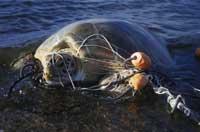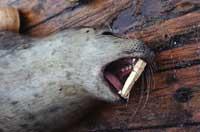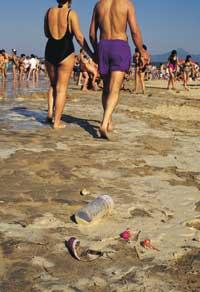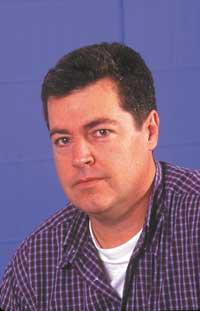The sea is a big trash can
2001/07/01 Mendiburu, Joana - Elhuyar Zientziaren Komunikazioa
As we approach the summer we realize the dirt that is in the sea, but without realizing it. In fact, when walking along the coast, plastic bottles, antique shoes, pieces of wood, etc. Although we see them, this is almost nothing compared to all marine pollution. In addition, it is considered that this "pinch" of dirt on the high seas has no influence, but that opinion is totally wrong.

The effects on marine ecosystems are of five types. First, the sea is exploited in excess and, in addition, more and more. Since 1995, the number of catches has multiplied by five and 16% of the animal protein consumed by each inhabitant comes from the sea. 26% of the oil used also comes from the sea. Other conditions include species introduction, habitat reduction and pollution of all kinds. On the latter, Juantxo López de Uralde, director of Greenpeace in Spain, gave a conference at the Aquarium in which some issues were clarified and the situation was clear. In his opinion, "two groups of pollutants can be differentiated: natural substances and artificial or chemical substances." Due to the different characteristics and origin of these residues, the imbalances that are generated are also very varied, although, ultimately, they cause the death of fauna and flora both.
Organic waste
In the words of Juantxo López de Uralde, "natural substances are thrown mainly into the sea in dirty waters, and although in normal concentrations nature is able to assimilate them, excessive concentrations cause an imbalance in ecosystems".
Imbalances are due to high levels of nitrogen and phosphorus in organic waste. In fact, when there is a lot of nitrogen and phosphorus, plankton reproduces without measure until it runs out of oxygen. Of course, with oxygen shortage drowns not only plankton, but the rest of the fauna. In addition, by increasing the plankton, the luminosity of the solar rays does not reach the bottom of the sea, so the vegetation dies. This reaction is called eutrophication.
Synthetic waste
Synthetic substances are rough (90% plastic), heavy metals and persistent organic pollutants, including hydrocarbons, pesticides known as DDT, lindane, dioxins from incinerations, etc. Nature lacks mechanisms of degradation of synthetic waste, so it takes a long time to recover. The main origin of chemical waste is industry. The industrial zones are located in the vicinity of the rivers and ports and the waste they throw are of high concentration. As we recall, industries have left such dramatic examples as Doñana. In addition to industries, port activities generate a large amount of waste, since oil changes on ships and maintenance of all kinds are often negligently carried out.
Also, the dredging of the soil of the ports is also seriously affected. This is because the dredging land is expelled a thousand further, so that by increasing the amount of suspended substances there is contamination of another ecosystem due to the abundance of pollutants.

Finally, we cannot forget the 27,000 ships that circulate from one side to the other. These boats are responsible for conventional pollution, garbage, products launched when cleaning the boat and TVD paintings. These paintings prevent the proliferation of microorganisms and algae on the outside of the boat, so neither does the proliferation of plankton occur in the vicinity. In addition to the usual, such as these sad examples we have seen this winter, accidental contamination also occurs. In most cases it is oil spills, but as in the case of Ievoli Sun styrene was issued, other chemicals have been released. The oil that is launched through these accidents represents 12% of the output to the sea.
Although no one surprises, Juantxo López de Uralde highlights that all these waste have serious consequences for marine fauna and flora. For example, heavy metals accumulate in fatty tissues and as they advance in the trophic chain concentrations increase. Metals cause abnormalities or tumors and cancers in the sex organs of animals.
Impurities poured by man on the banks of the river or abandoned on the beach also have many consequences on animals. Many animals drown as a result of macrowaste, others get trapped in the nets without being able to move or defend or die by ingestion of plastic pieces.
Finally, the effects of oil, oil or any chemical are also no sweeter. The images of oil birds are enough to see the painful consequences of transport in unfavorable conditions. However, these accidents are punctual and with long-term effects, and although those responsible tend to believe that the situation is controlled, nature takes 10-15 years to turn around this type of spills.
Global solutions
Industrialized areas, places where accidents and spills have occurred… no wonder these areas are contaminated. But in the sea and in the atmosphere there are many movements and currents that make the pollution move from one side to another exceeding all limits. Heavy waste is displaced by sea currents and gases by the so-called distillation mechanism. First they climb into the atmosphere, there they move from one side to another and then precipitate.

For this reason, apparently uncontaminated places also appear to be contaminated and, for example, although there is no industry in the Arctic, the sexual organs of their bears show anomalies by heavy metals.
The problem is therefore global and it is believed that the solution will also be achieved through international cooperation. In the words of Juantxo López de Uralde, "the solution will be achieved with international agreements, something that has shown us the experience of 30 years. For example, as leaded gasoline has been banned, the concentration of lead in the atmosphere has been reduced. Given these kinds of examples, it's time to put aside the concept of dilution to drive waste free production."
For practical examples, the implementation of legislation for the collection of waste equipped by the port and the purification of all urban wastewater must be done as soon as possible. The only solution to reduce the accidents of the ships is to strengthen the safety measures of the ships".
Dirt from the beachesThe beach season started long ago and the good weather days the beaches are crowded. Now, as soon as the sun rises and with the intention of leaving the beach in perfect condition, the cleaners begin to collect the impurities that the sea has left in the sand. And they have no easy work! According to a report prepared by the IFREMER (French Marine Research Institute), a person generates a liter of waste per day. These residues are usually food, cigarettes, newspapers, sunscreens and suits, which if they are not poured directly into the trash accumulate hidden under the sand. In addition to the rubbish thrown by beach users, those thrown into rivers and dropped from landfills located on the coast can also end up on the coast. In these landfills are usually deposited all kinds of waste from the washing machine to the oil. In the most serious cases, the sea, with the passage of time, produces erosions and finally all the dirt falls to the sea. The last regrettable example was the fall to the sea of the Bens landfill (La Coruña) in 1996. Arriving from the beach, landfills or rivers, in the Bay of Biscay, at a depth of between 0 and 200 meters, there are 50 million objects! and in the North Sea 70,000 m 3 boats are thrown! The amount of these residues is not insignificant and from now on, when going to the beach, it must be taken into account that the dirt starts with what one has ceded. |
Published in the supplement Natura de Gara.

Gai honi buruzko eduki gehiago
Elhuyarrek garatutako teknologia





